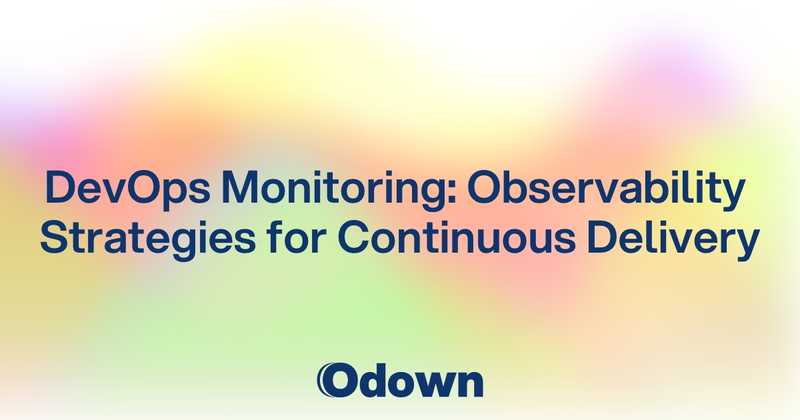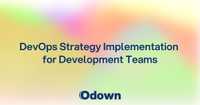DevOps Monitoring: Observability Strategies for Continuous Delivery
Your deployment pipeline is green. Tests are passing. Code is shipping to production multiple times per day. From the outside, your DevOps transformation looks like a complete success. Then you discover that your mean time to recovery (MTTR) has actually increased, your production incidents are more frequent than before, and your team spends more time firefighting than building new features.
The problem isn't with DevOps practices themselves - it's with monitoring strategies that haven't evolved to match modern deployment patterns. Traditional monitoring approaches assume relatively stable, infrequently changing systems. DevOps environments change constantly, making it difficult to establish baselines, correlate problems with changes, and maintain visibility into increasingly complex deployment pipelines.
DevOps monitoring requires fundamentally different approaches that embrace change as normal rather than exceptional. You need observability strategies that work with dynamic infrastructure, frequent deployments, and distributed teams that share responsibility for system reliability.
Monitoring in the DevOps Pipeline: From Code to Production
DevOps monitoring must span the entire software delivery lifecycle, providing visibility from initial code commits through production deployment and ongoing operations.
Development Environment Monitoring
Development environment monitoring helps teams identify performance and reliability issues early in the development cycle when they're cheaper and easier to fix.
Local development environment monitoring tracks developer productivity metrics like build times, test execution duration, and development server responsiveness that affect developer experience and code quality.
Code quality monitoring integrates with development workflows to track technical debt accumulation, code complexity trends, and potential performance issues before they reach production.
Branch and feature monitoring provides visibility into how different code branches perform in isolated environments, enabling teams to identify performance regressions before code merges.
Developer workflow monitoring tracks how development tool performance affects productivity and identifies opportunities for development environment optimization.
Staging and Pre-Production Monitoring
Staging environments require monitoring that validates production readiness while identifying issues that might not be obvious in development environments.
Integration testing monitoring tracks how well different system components work together and identifies integration issues that unit tests might miss.
Load testing monitoring validates system performance under realistic traffic patterns and identifies scalability bottlenecks before production deployment.
Data migration monitoring ensures that database changes and data transformations work correctly without causing data loss or corruption.
Configuration validation monitoring verifies that production-like configurations work correctly and don't introduce security or performance issues.
Security testing integration monitors vulnerability scanning, penetration testing, and compliance validation results as part of pre-production workflows.
Production Deployment Monitoring
Production deployment monitoring provides immediate feedback about deployment success and enables rapid rollback when problems occur.
Deployment impact monitoring tracks key performance indicators immediately after deployments to identify regressions that might not trigger traditional alerting.
Canary deployment monitoring gradually exposes new code to production traffic while comparing performance against baseline deployments.
Blue-green deployment monitoring tracks traffic routing and performance across different deployment environments during production switches.
Feature flag monitoring ensures that feature toggles work correctly and don't introduce performance overhead or functionality issues.
Rollback monitoring tracks rollback procedures and validates that rollback operations restore expected system behavior and performance.
Infrastructure as Code Monitoring: Terraform and CloudFormation
Infrastructure as Code (IaC) introduces new monitoring requirements because infrastructure changes become frequent, automated, and distributed across development teams.
Infrastructure Change Monitoring
Infrastructure change monitoring tracks modifications to cloud resources, network configurations, and security policies that might affect application performance or availability.
Terraform state monitoring tracks infrastructure state changes and identifies drift between declared configurations and actual resource states.
CloudFormation stack monitoring provides visibility into AWS infrastructure changes and identifies stack update failures or resource creation issues.
Resource compliance monitoring ensures that infrastructure changes maintain security policies, cost controls, and operational standards.
Infrastructure dependency monitoring tracks relationships between infrastructure components and identifies how changes might affect dependent systems.
Cost and Resource Optimization
Infrastructure cost monitoring becomes critical when teams can provision resources independently through IaC workflows.
Resource utilization monitoring tracks how efficiently provisioned infrastructure gets used and identifies opportunities for cost optimization.
Rightsizing monitoring compares actual resource usage against provisioned capacity to identify over-provisioned or under-provisioned resources.
Reserved instance monitoring tracks reserved capacity usage and identifies opportunities for cost optimization through better reservation management.
Spot instance monitoring tracks the usage and interruption patterns of cost-optimized compute resources.
Infrastructure Security Monitoring
Security monitoring for IaC environments must track configuration compliance and identify security misconfigurations that automated provisioning might introduce.
Configuration drift monitoring identifies when actual infrastructure configurations deviate from security baselines or compliance requirements.
Access control monitoring tracks who can modify infrastructure and ensures that permissions align with organizational security policies.
Secret management monitoring ensures that infrastructure code doesn't expose sensitive information and that secrets rotate appropriately.
Network security monitoring tracks security group changes, firewall rule modifications, and network access control updates.
CI/CD Pipeline Monitoring: Build, Test, and Deploy Visibility
Continuous integration and continuous deployment pipelines require specialized monitoring to ensure that automated workflows function reliably and efficiently.
Build Pipeline Performance
Build pipeline monitoring tracks the efficiency and reliability of code compilation, testing, and packaging processes.
Build time monitoring helps identify bottlenecks in compilation, dependency resolution, and artifact creation that slow development velocity.
Test execution monitoring tracks test suite performance, failure rates, and coverage metrics that affect code quality and deployment confidence.
Artifact storage and retrieval monitoring ensures that build artifacts are stored reliably and can be retrieved efficiently for deployment processes.
Build environment monitoring tracks the health and performance of build servers, containers, and cloud-based build services.
Dependency management monitoring tracks external dependency availability and identifies when dependency issues affect build reliability.
Test Automation Monitoring
Automated testing monitoring provides visibility into test effectiveness and identifies opportunities for improving test coverage and reliability.
Unit test monitoring tracks test execution time, success rates, and coverage metrics that affect development workflow efficiency.
Integration test monitoring reveals how well different system components work together and identifies integration issues that require attention.
End-to-end test monitoring validates complete user workflows and identifies issues that component-level testing might miss.
Performance test monitoring tracks application performance under load and identifies performance regressions before production deployment.
Security test monitoring integrates vulnerability scanning and security testing results into development workflows.
Deployment Pipeline Monitoring
Deployment pipeline monitoring ensures that code moves reliably from development through production while maintaining quality and security standards.
Pipeline stage monitoring tracks the success rates and duration of each deployment stage to identify bottlenecks and reliability issues.
Environment promotion monitoring tracks how code moves between different environments and identifies issues specific to particular deployment targets.
Approval workflow monitoring tracks manual approval processes and identifies where human bottlenecks affect deployment velocity.
Deployment frequency monitoring tracks how often teams ship code and correlates deployment frequency with quality metrics.
Lead time monitoring measures the time from code commit to production deployment to identify opportunities for process improvement.
Pipeline Failure Analysis
Pipeline failure analysis helps teams understand why deployments fail and how to improve pipeline reliability.
Failure pattern analysis identifies common failure modes and helps teams implement preventive measures.
Recovery time monitoring tracks how quickly teams can resolve pipeline failures and resume normal deployment operations.
Rollback effectiveness monitoring ensures that rollback procedures work reliably when deployments encounter problems.
Post-deployment monitoring tracks application behavior after successful deployments to identify issues that might not be obvious immediately.
DevOps Culture: Building Teams That Monitor and Improve
Successful DevOps monitoring requires cultural changes that emphasize shared responsibility, continuous improvement, and data-driven decision making.
Shared Responsibility Models
DevOps monitoring succeeds when development and operations teams share responsibility for system reliability rather than treating monitoring as purely an operations concern.
Developer monitoring ownership encourages development teams to implement monitoring as part of feature development rather than as an afterthought.
Cross-functional alerting ensures that alerts reach the people best equipped to resolve problems regardless of traditional organizational boundaries.
Incident response collaboration brings development and operations teams together during incidents to accelerate problem resolution and learning.
Knowledge sharing practices ensure that monitoring expertise spreads across teams rather than concentrating in specialist roles.
Continuous Improvement Practices
DevOps monitoring should drive continuous improvement rather than just reactive problem-solving.
Retrospective analysis uses monitoring data to identify systemic issues and improvement opportunities that go beyond individual incident resolution.
Experimentation and A/B testing integrate with monitoring to validate that changes actually improve system performance and user experience.
Monitoring-driven development uses observability data to guide feature development and architectural decisions.
Performance budgets set measurable targets for system performance and use monitoring data to track progress toward those targets.
Monitoring Literacy and Education
Building monitoring literacy across development teams ensures that monitoring becomes integral to development practices rather than an external requirement.
Monitoring training helps developers understand how to implement effective observability and how to interpret monitoring data for troubleshooting.
Dashboard design workshops teach teams how to create effective visualizations that support decision-making rather than just displaying data.
Alert tuning education helps teams balance alerting sensitivity with alert fatigue to maintain effective incident response.
Observability as code practices treat monitoring configuration as code that gets reviewed, tested, and version controlled alongside application code.
Metrics-Driven Decision Making
DevOps culture emphasizes using data rather than intuition for decision-making about system architecture, performance optimization, and operational procedures.
SLI/SLO implementation helps teams set measurable reliability targets and track progress toward those targets using objective data.
Error budget management uses monitoring data to balance feature development velocity with system reliability requirements.
Capacity planning integrates monitoring data with business growth projections to make informed infrastructure investment decisions.
Cost optimization uses monitoring data to correlate system performance with infrastructure costs and identify optimization opportunities.
Tool Integration and Automation
DevOps monitoring requires tool integration that reduces manual work and enables automated responses to common operational issues.
Monitoring as code treats observability configuration as part of application deployment, ensuring that monitoring evolves alongside application development.
Automated remediation uses monitoring data to trigger automatic responses to common problems, reducing manual operational overhead.
ChatOps integration brings monitoring data into team communication tools to enable collaborative problem-solving and knowledge sharing.
Compliance automation uses monitoring data to validate that systems meet regulatory and security requirements without manual audit processes.
DevOps monitoring transforms software delivery from a series of disconnected stages into an integrated, observable, and continuously improving system. Instead of discovering problems after they affect users, teams get visibility into every stage of the delivery process and can optimize based on real data.
The investment in comprehensive DevOps monitoring pays dividends in faster delivery velocity, improved system reliability, and reduced operational overhead. Teams finally get the visibility and automation needed to deliver software reliably at high velocity.
Ready to implement comprehensive DevOps monitoring? Odown provides integrated monitoring that spans development, deployment, and production environments with the automation and alerting capabilities that DevOps teams need. Combined with our e-commerce monitoring strategies, you'll have complete visibility into both your delivery process and the business impact of the applications you're building and deploying.



